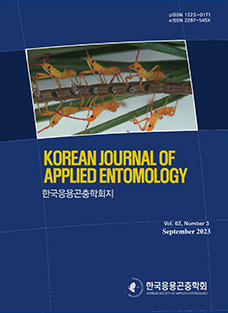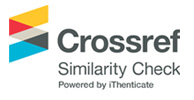![]() Journal Search Engine
Journal Search Engine
ISSN : 2287-545X(Online)
DOI : https://doi.org/10.5656/KSAE.2012.01.1.063
한국산 고려긴가슴잎벌레(딱정벌레목: 잎벌레과) 유충에 대한 연구
초록
Larva of Lilioceris (Lilioceris) ruficollis (Coleoptera: Chrysomelidae) from Korea
Abstract
- Materials and Methods
- Taxonomic Accounts
- Genus Lilioceris Reitter, 1912.
- Diagnosis of the genus Lilioceris Reitter.
- Lilioceris (Lilioceris) ruficollis (Baly, 1865)
- Diagnosis
- Descriptions
- First instar larva
- Last instar larva
- Head
- Materials examined
- Distribution
- Host plant
- Remarks
- Biological note
- Acknowledgment
The genus Lilioceris Reitter, 1912 is distributed throughout the Palaearctic, Oriental and Ethiopian regions. According to Lopatin (1977), 40 species are known in the Palaearctic Region (mainly eastern Asia). In Korea, the genus is represented by eight species as Lilioceris (Chujoita) gibba (Baly, 1861), Lilioceris (Lilioceris) cyaneicollis (Pic, 1916), L. (L.) merdigera (Linnaeus, 1758), L. (L.) ruficollis (Baly, 1865), L. (L.) rufometallica(Pic, 1923), L. (L.) scapularis (Baly, 1859), L. (L.) sinica(Heyden, 1887) and L. (L.) triplagiata (Jacoby, 1888) (Lee and An, 2001). Many of them are important pests on medicinal plants and garden flowers [(lily; yam; etc) Lee et al., 200;, Jang et al., 2010; Kwon et al., 2010]. There have been a few studies on the adult taxonomy of Korean Lilioceris (Gressitt and Kimoto, 1961; An et al., 1986; An and Kwon, 1995; An, 1995, 1996, 1998; Lee and An, 2001). Although the main damage to the plants is caused by their larvae, nothing is known about the larvae of Korean Lilioceris. L. (L.) ruficollis is associated with Dioscorea (Dioscoreaceae), especially D. septemioba which is a well-known medicinal plant in Korea.
In the present paper, detailed descriptions and illustrations of the larva of L. (L.) ruficollis are provided for the first time. Some remarks on their biology are also given.
Materials and Methods
Larvae of L. (L.) ruficollis were reared on the host plants,Dioscorea spp. in the laboratory. The specimens used in this study were preserved in 70% ethyl alcohol. For morphological study, they were cleared in 10% KOH solution for 30 minutes and then rinsed in water. The dissection was done under a stereoscopic microscope (SZX12; Olympus, Japan). For morphological studies of the minute structure, slides were made for the body part and observed through the compound microscope (SZ4045; Olympus, Japan). The terminology follows Anderson (1947) and Kimoto (1962).
Taxonomic Accounts
Subfamily Criocerinae Lacordaire, 1845.
Genus Lilioceris Reitter, 1912.
Diagnosis of the genus Lilioceris Reitter.
Dorsum with distinct tubercles, at least with small obscure tubercles on meso- and metathorax, or meso- and metathorax each with two rows of setae dorsally.
Subgenus Lilioceris Reitter, 1912.
Lilioceris (Lilioceris) ruficollis (Baly, 1865)
Crioceris ruficollis Baly, 1865. Ann. Mag. Nat. Hist., ser. 3, 16, p. 155 (N. China).
Crioceris sieversi Heyden, 1887. Horae Soc. Ent. Ross., 21, p.27 (Korea).
Lilioceris (Lilioceris) ruficollis: An et al., 1986. Ins. Kor. 6: 125-126.
Lilioceris (Lilioceris) ruficollis: An, 1995. Cheju. Folkl. & Nat.Hist. Mum.: 154.
Lilioceris (Lilioceris) ruficollis: An, 1996. Res. Bull. Nat. Sci.Mus. 13: 42.
Lilioceris (Lilioceris) ruficollis: An et Kwon, 1995. Ins. Kor.Suppl. 5: 92.
Diagnosis
Diagnosis. Body densely stippled with minute elevations; anterior margin of labrum deeply notched on anterior margin, with three pairs of setae and two pairs of sensilla.
Descriptions
First instar larva
First instar larva (Fig. 2A). Similar to mature larva except for following characters: body length 1.8 ± 0.2 mm, width 0.5 ± 0.1mm, head width 0.36 ± 0.02 mm (n=5); head color black and body color white. Egg bursters (Fig. 1F) present on dorso-lateral region of metathorax.
 Fig. 1. Lilioceris (Lilioceris) ruficollis (Baly). A. last instar larva (l.v.); B. mandible (b.v.); C. head (d.v.); D. spiracle (thoracic, d.v.); E. pronotum (d.v.); F. egg bursters (d.v.); G. lower mouth parts (d.v.); H. tibia (d.v.); I. antenna (d.v.); J. clypeus and labrum (v.v and d.v.). b.v.: buccal view;d.v.: dorsal view; l.v.: lateral view; v.v.: ventral view.
Fig. 1. Lilioceris (Lilioceris) ruficollis (Baly). A. last instar larva (l.v.); B. mandible (b.v.); C. head (d.v.); D. spiracle (thoracic, d.v.); E. pronotum (d.v.); F. egg bursters (d.v.); G. lower mouth parts (d.v.); H. tibia (d.v.); I. antenna (d.v.); J. clypeus and labrum (v.v and d.v.). b.v.: buccal view;d.v.: dorsal view; l.v.: lateral view; v.v.: ventral view.
Last instar larva
Last instar larva (Fig. 1A-E, G-J; Fig. 2B). Body length 8.0 ±1.5 mm, width 2.6 ± 0.3 mm, head width 1.2 ± 0.1 mm (n=10). Body arched, brownish, covered with a slimy mucous secretion usually bearing excrement. Dorsum densely stippled with minute elevations.
 Fig. 2. Lilioceris (Lilioceris) ruficollis (Baly). A. first instar larva; B. last instar larva.
Fig. 2. Lilioceris (Lilioceris) ruficollis (Baly). A. first instar larva; B. last instar larva.
Head
Head (Fig. 1C). Hypognathous, orange, well sclerotized, epicranial suture Y-shaped; frontal suture distinct. Stemmata well developed, six in number. Endocarina absent; frons with 5pairs of frontal setae and 1 pair of sensilla. Clypeus (Fig. 1J) trapezoid, with 2 pairs of setae and 1 pair of sensilla; labrum brown, deeply notched on anterior margin, with 3 pairs of setae and 2 pairs of sensilla; epipharynx with 7 pairs of setae. Antenna(Fig. 1I) two-segmented. Mandible (Fig. 1B) with 5 distal teeth and 3 mandibular setae and 1 sensillum. Maxillary palp three-segmented; palpifer with 1 seta; stipes with two setae; cardo with 1 seta (Fig. 1G). Lacinia fused with stipes; galea with 10 setae; Labial palp (Fig. 1G) one-segmented with 1 sensillum; prementum with four pairs of setae and 2 pairs of sensilla; postmentum with 2 pairs of setae.
Thorax. Pronotum (Fig. 1E) pale brown, sclerotized, with 14pairs of setae. Meso-and metathorax with small obscure tubercles on dorsum. Thoracic spiracles (Fig. 1D) biforous. Legs long and slender; tibia (Fig. 1H) with 5 setae; tarsus strongly curved, hook-like; pulvillus present.
Abdomen. Abdominal spiracles present on segments I-VIII similar to prothoracic spiracles but smaller. Anal opening present on abdominal segment IX.
Materials examined
Materials examined. 10 exs., Doreokdo Isl., Yeosu City, Jeollanam-do, 29.V. 2010, J.Y. Park; 20 exs., Sanggyedo Isl., Yeosu City, Jeollanam-do, 13. VI. 2010, J.Y. Park.
Distribution
Distribution. Korea, China, Japan.
Host plant
Host plant. Dioscorea spp. (D. septemioba, D. batatas and D.japonica)
Remarks
Remarks. This species is easily separable from the known Criocerine larvae by numerous spines present on mosaic-like microsculpture of the tergum except for the prothorax.
Biological note
Biological note. This species has a single generation per year, overwinters in the adult stage. Adults appear in early April, begin ovipositing in early May. Eggs are laid singly inside or surface of the leaf. The larvae have a habit of accumulating their feces on their body, which serves them as a protection. The body of the larvae can also be enclosed in mucus. They then burrow themselves underground to pupate in a cocoon formed by saliva and small particles of soil. The emergence of adults starts in early June and lasts until later July. The total life cycle from egg to adult ranged from 30 to 35 days room temperature.
Acknowledgment
This research was supported by Kyungpook National University Research Fund, 2010.
Reference
 14.Kimoto, S. 1962. A phylogenetic consideration of Chrysomelidae based on immature stages of Japanese species. J. Fac. Agric. Kyushu Univ. 12: 67-116.
15.Kwon, J.B., M.S. Kim and H.Y. Sohn. 2010. Evaluation of antimicrobial, antioxidant, and antithrombin activities of the rhizome of various Dioscorea species. Kor. J. Food Preserv. 17: 391-397.
16.Lee, J.E. and S.L. An. 2001. Economic insects of Korea 14 (Chrysomelidae). 231pp. Junghaengsa, Korea.
17.Lee, W.C., H.S. Jung and N.W. Sohn. 2004. Neuroprotective effects of medicinal herbs in organotypic hippocampal slice cultures. Kor. J. Orient. Int. Med. 25: 461-472.
18.Lacordaire, M.T. 1845. Monographie des Coleopteres subpentameres de la Famille des Phytophages. Tome I. Mémoires de la Société Royale des Sciences de Liége 3: 1-740.
19.Lopatin, I. 1977. Leaf beetles (Chrysomelidae) of Middle Asia and Kazakhistan. Nauka, Leningrad. p. 1-268.
20.Pic. M. 1916. Descriptions abrégés diverses. Mélang. Exotic. Entomol., Moulins. 20: 1-20.
21.Reitter, E. 1912. Fauna Germanica Coleopterorum-Schrift. Deutsch. Lehrerver. Naturk. Stuttgart, Bd. 4: 72-218.
14.Kimoto, S. 1962. A phylogenetic consideration of Chrysomelidae based on immature stages of Japanese species. J. Fac. Agric. Kyushu Univ. 12: 67-116.
15.Kwon, J.B., M.S. Kim and H.Y. Sohn. 2010. Evaluation of antimicrobial, antioxidant, and antithrombin activities of the rhizome of various Dioscorea species. Kor. J. Food Preserv. 17: 391-397.
16.Lee, J.E. and S.L. An. 2001. Economic insects of Korea 14 (Chrysomelidae). 231pp. Junghaengsa, Korea.
17.Lee, W.C., H.S. Jung and N.W. Sohn. 2004. Neuroprotective effects of medicinal herbs in organotypic hippocampal slice cultures. Kor. J. Orient. Int. Med. 25: 461-472.
18.Lacordaire, M.T. 1845. Monographie des Coleopteres subpentameres de la Famille des Phytophages. Tome I. Mémoires de la Société Royale des Sciences de Liége 3: 1-740.
19.Lopatin, I. 1977. Leaf beetles (Chrysomelidae) of Middle Asia and Kazakhistan. Nauka, Leningrad. p. 1-268.
20.Pic. M. 1916. Descriptions abrégés diverses. Mélang. Exotic. Entomol., Moulins. 20: 1-20.
21.Reitter, E. 1912. Fauna Germanica Coleopterorum-Schrift. Deutsch. Lehrerver. Naturk. Stuttgart, Bd. 4: 72-218.
Vol. 40 No. 4 (2022.12)

Frequency Quarterly
Doi Prefix 10.5656/KSAE
Year of Launching 1962
Publisher Korean Society of Applied Entomology



Online Submission
submission.entomology2.or.kr
 KSAE
KSAE
The Korean Society of Applied Entomology








